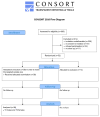Oral Health of 7- to 9-Year-Old Children Born Prematurely-A Case-Control Observational Study with Randomized Case Selection
- PMID: 39727478
- PMCID: PMC11674599
- DOI: 10.3390/dj12120421
Oral Health of 7- to 9-Year-Old Children Born Prematurely-A Case-Control Observational Study with Randomized Case Selection
Abstract
Background: Along with the long-term sequelae of preterm birth for general health, oral health is potentially influenced by prematurity due to developmental and behavioral peculiarities. Objectives: This study aimed to compare oral health parameters in the mixed dentition of prematurely and full-term born children. Methods: Dental caries, developmental defects of enamel (DDE), and gingival inflammation were assessed in 7-to-9-year-old children (n = 38) born preterm (PT) compared to a matched control group born full-term (FT) in Germany. Dental caries was recorded using the International Caries Detection and Assessment System (ICDAS II) and DMFT/dmft-criteria. DDE was scored with modified DDE-Index and periodontal health by Periodontal Screening Index (PSI). Statistical analysis included McNemar's test and Poisson regression. The significance level was p ≤ 0.05. Results: Caries prevalence was 47.4% in PT and 57.9% in FT. In the primary dentition, FT children were significantly more affected than PT children (1.6 dmft vs. 2.7 dmft; p = 0.035). PT children with extremely low birthweight (ELBW) had the highest caries experience (3.2 dmft; 1.0 DMFT). Prevalence of DDE in primary teeth was significantly higher in PT (55.3%) than in FT children (28.9%; p = 0.008). PSI was 3.8 in PT and 3.3 in FT children, but significantly higher in PT children with ELBW (7.4; p = 0.125). Conclusions: PT children are at higher risk for DDE in primary teeth and compromised periodontal health than FT children. Children with ELBW are most susceptible for dental caries and gingivitis.
Keywords: dental caries; developmental defects of enamel; prematurity.
Conflict of interest statement
The authors declare no conflicts of interest.
Figures
Similar articles
-
Dental Caries and Developmental Defects of Enamel in the Primary Dentition of Preterm Infants: Case-Control Observational Study.Caries Res. 2018;52(1-2):22-31. doi: 10.1159/000480124. Epub 2017 Dec 9. Caries Res. 2018. PMID: 29224001
-
Developmental defects of enamel in children born preterm.Front Pediatr. 2022 Oct 13;10:1019586. doi: 10.3389/fped.2022.1019586. eCollection 2022. Front Pediatr. 2022. PMID: 36313889 Free PMC article.
-
Enamel defects and caries prevalence in preterm children aged 5-10 years in Dubai.Libyan J Med. 2020 Dec;15(1):1705633. doi: 10.1080/19932820.2019.1705633. Libyan J Med. 2020. PMID: 31873070 Free PMC article.
-
Community-based population-level interventions for promoting child oral health.Cochrane Database Syst Rev. 2016 Sep 15;9(9):CD009837. doi: 10.1002/14651858.CD009837.pub2. Cochrane Database Syst Rev. 2016. Update in: Cochrane Database Syst Rev. 2016 Dec 22;12:CD009837. doi: 10.1002/14651858.CD009837.pub3. PMID: 27629283 Free PMC article. Updated. Review.
-
Oral health inequalities in immigrant populations worldwide: a scoping review of dental caries and periodontal disease prevalence.BMC Public Health. 2024 Jul 23;24(1):1968. doi: 10.1186/s12889-024-19354-4. BMC Public Health. 2024. PMID: 39044172 Free PMC article.
References
-
- Wolke D., Johnson S., Mendonça M. The Life Course Consequences of Very Preterm Birth. Annu. Rev. Dev. Psychol. 2019;1:69–92. doi: 10.1146/annurev-devpsych-121318-084804. - DOI
-
- Ohuma E.O., Moller A.-B., Bradley E., Chakwera S., Hussain-Alkhateeb L., Lewin A., Okwaraji Y.B., Mahanani W.R., Johansson E.W., Lavin T., et al. National, regional, and global estimates of preterm birth in 2020, with trends from 2010: A systematic analysis. Lancet. 2023;402:1261–1271. doi: 10.1016/S0140-6736(23)00878-4. - DOI - PubMed
-
- Schleußner E. Drohende Frühgeburt: Prävention, Diagnostik und Therapie. Dtsch. Arztebl. 2013;110:227–236. (In German)
LinkOut - more resources
Full Text Sources


